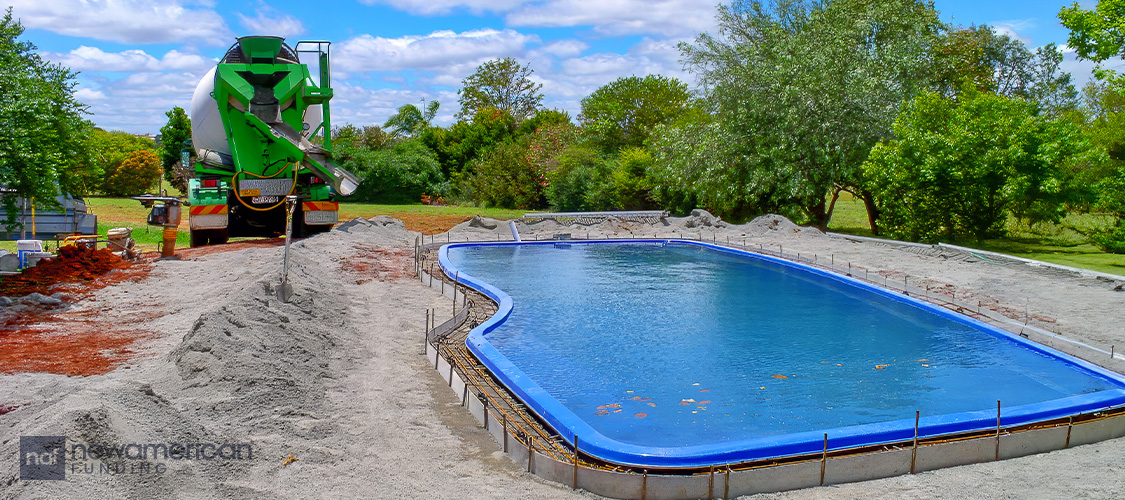Homeowners
Make a Splash: 6 Ways to Finance a New Pool for Your Home
May 26, 2025
Good music, good food, and good friends—that’s all you need for an epic pool party. Oh yeah, and a pool. You’re going to need one of those, too.
A pool also drives up the value of your home. A recent report from Realtor.com found that homes with pools cost about 54% more than homes without the summer oases. (These properties also tend to be larger, which accounts for some of the premium.)
However, pools are often expensive. The average in-ground pool costs nearly $66,000 to install, according to Angi, a home services company.
Fortunately, homeowners may be able to tap into their home equity to help pay for one. Let’s take a dip into the various financing options available.
Among your options for financing a pool are a home equity loan or Home Equity Line of Credit (HELOC), a cash-out refinance, a personal loan, a construction loan, or even financing through the manufacturer.
But how do you know which option is right for you?
“It depends,” said Amber Ernst, sales manager at New American Funding. “Do you have the home equity? How much is the pool project? How much is your house worth now and after the pool? What is your current mortgage rate? You want to make sure it all aligns and makes sense financially.”
A home equity loan to finance a pool is great if you have equity

An home equity loan is a loan that allows you to borrow against the equity you have in your home to pay for your pool.
However, there are a few caveats to using a home equity loan for a pool:
- You need enough equity in your home to be eligible.
- It usually takes about a month to close. If you’re ready to start pool construction now, you may need to consider a different financing source.
- You’ll have to pay closing costs (usually 2% to 5% of the loan amount).
When to use a home equity loan for a pool: When you have significant equity in your home and know exactly how much you need to borrow for the installation.
A HELOC might offer more flexibility for ongoing renovations
A Home Equity Line of Credit (HELOC) also lets you borrow against the equity in your home to pay for your pool.
A HELOC has a variable interest rate, meaning it can change over time. More importantly, HELOCs have a draw period, during which you can borrow what you need.
These draw periods usually last around five years, which can be helpful if your pool installation is one phase of a larger backyard transformation—maybe a new deck, an outdoor kitchen, or all-new landscaping.
After the draw period, you’ll have a repayment period (usually 10 to 20 years) to repay what you borrowed.
When to use a HELOC for a pool: When you have significant equity in your home and are completing multiple expensive projects over the next few years.
Consider a cash-out refi to pay for a pool

Both home equity loans and HELOCs are great if you like your current mortgage rate. A cash-out refinance is good for those looking for larger amounts of money.
Like a regular mortgage refinance, you’ll replace your current mortgage with a new one. But your new mortgage will be for more than you owe on your home—and you’ll pocket that extra amount.
You can use that “bonus” money to put in a pool. Just note: This could increase your monthly mortgage payment, especially if mortgage rates are now higher, and extend how long you’ll be paying off your home.
These loans also generally take at least a month to close.
When to use a cash-out refinance for a pool: When you need a larger loan.
Use a personal loan for fast funding
You can use a personal loan for almost anything, including a pool. Personal loans can be funded within a few business days. Some lenders offer same-day funding.
Plus, personal loans don’t require equity in your home, and most are unsecured, meaning your home doesn’t serve as collateral.
The downside? Personal loans have higher interest rates (as high as 36%), which are much higher than home equity loans, HELOCs, and cash-out refinances. Personal loans also have shorter repayment periods (often two to seven years) than many other types of loans.
Plus, personal loans have origination fees (usually 2% to 8% of the loan amount). Many lenders cap borrowing amounts at $50,000 or less, which might be a little shy of how much you need for the pool.
When to use a personal loan for a pool: When you don’t have enough equity in your home, like your current mortgage rate, and want to start the project ASAP.
Use your home construction loan to add a pool

If you’re building your home from the ground up, you can take out a one-time close construction loan, which covers the cost of the land and actual building costs. Just make sure the pool is included in that new construction.
When to use a construction loan for a pool: When you’re building a new home and want to include a pool.
When all else fails, ask the manufacturer about financing for your pool
Some pool manufacturers and dealers may offer in-house financing. It’s worth asking about rates, repayment terms, and any special promotions.
But you should always compare what you’re offered to another funding source, such as a home equity loan or personal loan.
When to use manufacturer financing for a pool: When the manufacturer or dealer can offer a better deal than the alternatives.
Amber Ernst NMLS # 406037






 Smart Moves Start Here.
Smart Moves Start Here.